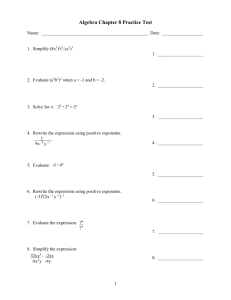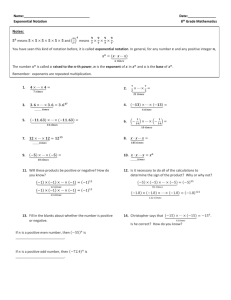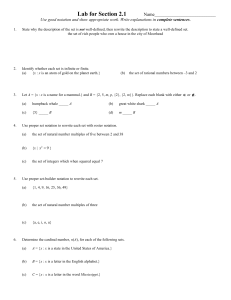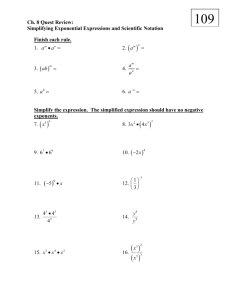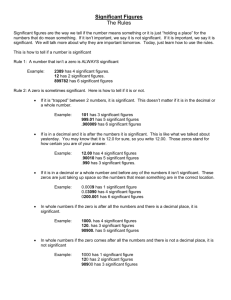WS 1.1 Scientific Notation
advertisement
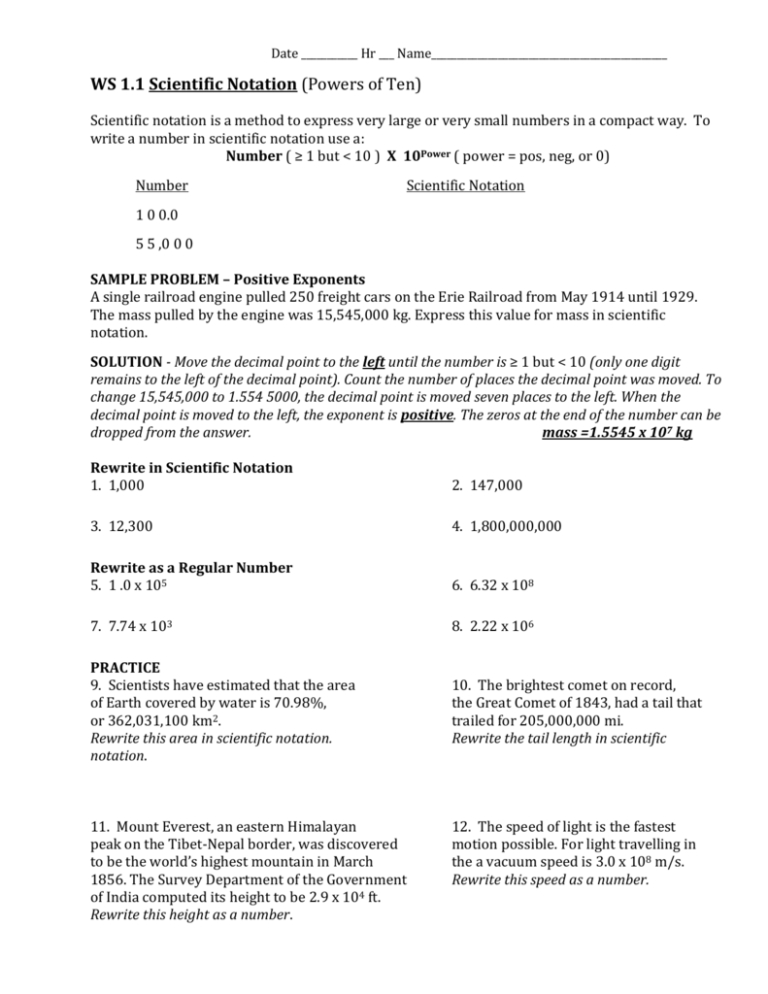
Date ___________ Hr ___ Name______________________________________________ WS 1.1 Scientific Notation (Powers of Ten) Scientific notation is a method to express very large or very small numbers in a compact way. To write a number in scientific notation use a: Number ( ≥ 1 but < 10 ) X 10Power ( power = pos, neg, or 0) Number Scientific Notation 1 0 0.0 5 5 ,0 0 0 SAMPLE PROBLEM – Positive Exponents A single railroad engine pulled 250 freight cars on the Erie Railroad from May 1914 until 1929. The mass pulled by the engine was 15,545,000 kg. Express this value for mass in scientific notation. SOLUTION - Move the decimal point to the left until the number is ≥ 1 but < 10 (only one digit remains to the left of the decimal point). Count the number of places the decimal point was moved. To change 15,545,000 to 1.554 5000, the decimal point is moved seven places to the left. When the decimal point is moved to the left, the exponent is positive. The zeros at the end of the number can be dropped from the answer. mass =1.5545 x 107 kg Rewrite in Scientific Notation 1. 1,000 2. 147,000 3. 12,300 4. 1,800,000,000 Rewrite as a Regular Number 5. 1 .0 x 105 6. 6.32 x 108 7. 7.74 x 103 8. 2.22 x 106 PRACTICE 9. Scientists have estimated that the area of Earth covered by water is 70.98%, or 362,031,100 km2. Rewrite this area in scientific notation. notation. 10. The brightest comet on record, the Great Comet of 1843, had a tail that trailed for 205,000,000 mi. Rewrite the tail length in scientific 11. Mount Everest, an eastern Himalayan peak on the Tibet-Nepal border, was discovered to be the world’s highest mountain in March 1856. The Survey Department of the Government of India computed its height to be 2.9 x 104 ft. Rewrite this height as a number. 12. The speed of light is the fastest motion possible. For light travelling in the a vacuum speed is 3.0 x 108 m/s. Rewrite this speed as a number. SAMPLE PROBLEM – Negative Exponents The diameter of the hydrogen atom has been measured to be about 0.00000001 m. Express this diameter in scientific notation. SOLUTION - Move the decimal point to the right until the number is ≥ 1 but < 10 (first nonzero digit is to the left of the decimal point). Count the number of places the decimal point was moved. To change 0.000 00001 to 1.0, the decimal point is moved eight places to the right. When the decimal point is moved to the right, the exponent is negative. d = 1.0 x 10–8 m Rewrite in Scientific Notation 13. 0.001 14. 0.000035 15. 0.0579 16. 0.000000000992 Rewrite as a Regular Number 17. 1 .0 x 10-2 18. 6.32 x 10-6 19. 7.74 x 10-3 20. 2.22 x 10-8 PRACTICE 21. In 1981 the IBM Zurich research laboratory invented the scanning tunneling microscope (STM). It has a magnifying ability of 100 million with resolution capability down to 0.0000000002 m, about the diameter of a sulfur atom. Rewrite the diameter in scientific notation. 22. One of the smallest of all free-living organisms, Mycoplasma laidlawii, was first discovered in sewage in 1936. During its early existence, its diameter can be as small as only 0.0000001 m. Rewrite this diameter in scientific notation. 23. The mass of the smallest bacterium is about 2 x 10-15 grams. Rewrite this mass as a number. 24. The density of helium is 1.78 x 10-4 g/cm3. Rewrite helium’s density without using scientific notation. 25. Although you cannot see it, the lights in a room flicker on and off several times a second. The flickering results from the electricity changing direction rapidly, causing the lights to brighten and dim repeatedly. This cycle occurs once every 0.0166 s. Rewrite this time interval in scientific notation. 26. The speed with which the shutter of a camera opens and shuts can be changed on certain models of cameras. On most 35 mm cameras, the fastest shutter speed is 0.001 s. Rewrite this time in scientific notation. Using Scientific Notation Do the following problems using your calculator. The keys used to enter a power of ten into your calculator will vary depending on the company and model of your calculator. The following are typical for most calculators models: Example: 1,700,000 x 350,000,000 = 1.7 x 106 x 3.5x 108 TI (Texas Instruments) Note: If your EE button is yellow or blue, and above another key, you must push the yellow 2nd function button first to make the EE active You type in : 1.7 EE 6 x 3.5 EE 8 = Your display : 1.7E6 x 3.5E8 Casio, Sanyo, etc...... You type in : Your display : 1.7 EXP 6 x 3.5 EXP 8 = 1.7E6 x 3.5E8 OR 1.7 06 x 3.5 08 PROBLEM The Concorde, a supersonic passenger jet that flies from the East Coast of the United States to London and Paris, must fly at the speed of a regular jet while flying over land. This lower speed is used to avoid problems associated with the sonic boom of supersonic jets. Once over the Atlantic Ocean, the Concorde can increase its speed. If the Concorde flies at 8.85 x 102 km/h over land and 2.300 x 103 km/h over sea, what is the difference in these speeds? SOLUTION Step 1: Write the Formula for the in difference in speeds Step 2: Plug the known values into the equation. Step 3: Do the math (Chug). Difference in speeds = sea speed – land speed Difference in speeds = (2.300 x 103 km/h) – (8.85 x 102 km/h) Use calculator OR Rewrite either value so that the exponent 2.300 x 103 km/h = 23.00 x 102 km/h term of both numbers is the same. Can only subtracts same exponents. Difference in speeds = (23.00 – 8.85) x 102 km/h Move the decimal point to the left until the number is ≥ 1 but < 10. Difference in speeds = 14.15 x 102 km/h Difference in speeds = 1.415 x 103 km/h PRACTICE 27. 2.300 x 103 - 8.85 x 102 = 28. 4.5 x 104 x 7.7 x 107 = 29. 2.54 x 102 / 1.93 x 101 = 30. 7.35 x 10-8 + 4.703 x 10-6= Put all numbers and answers in scientific notation. 31. The heaviest commonly used United States coin is the half dollar, which has a mass of 11.340 g. The lightest United States coin is the dime, which has a mass of 2.268 g. Report the sum of these masses in scientific notation. 32. A signal is transmitted between four microwave signal towers. The distances between the towers is 2.50 km, 2.500x 101 km, and 5.0 x 10–1 km. What is the total distance traveled by the signal? 33. The adult house fly lives for only about 1 month, or 8 x 10-2 y. The oldest recorded age of a tortoise was 1.88 x 102 y. What is the difference, in scientific notation, between these two ages? 34. The ink needed to dot an i in this book has a mass of around 0.0000000011 kg. What is the mass of ink needed to dot all of the i’s in this problem? 35. The Republic of China presented one of the world’s largest flags to the city of Kaohsiung in 1989. The flag of the Republic of China measured 1.26 x 104 cm by 8.40 x 103 cm. What is the area of this flag in square centimeters?


